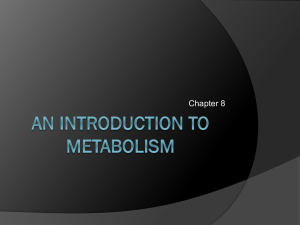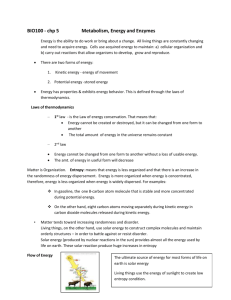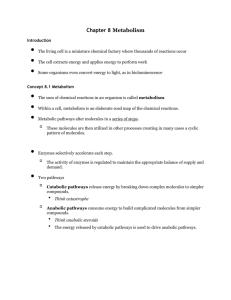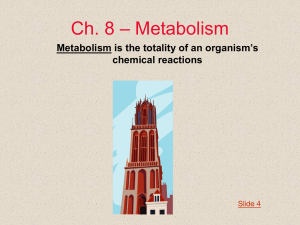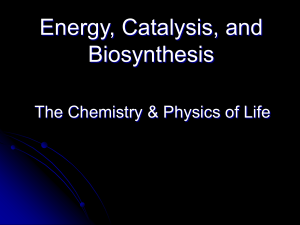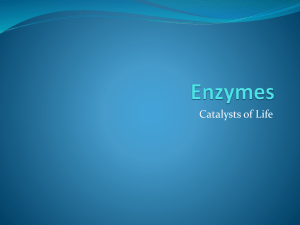Ch 8 Notes
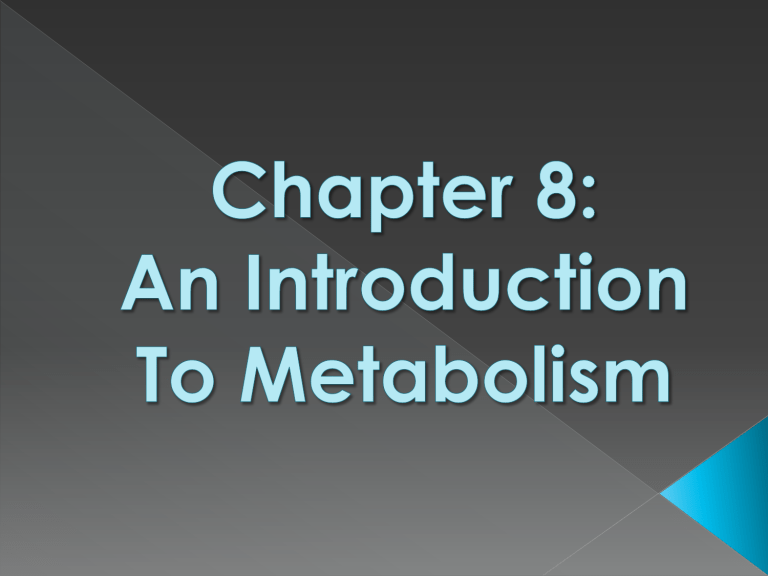
2.a.1 – All living systems require constant input of free energy (8.1-8.3).
4.b.1 – Interactions between molecules affect their structure and function (8.4 &
8.5).
The totality of an organism’s chemical processes
Concerned with managing the material and energy resources of the cell
Pathways that break down complex molecules into smaller ones, releasing energy
Example: Cellular respiration
DOWNHILL!
Pathways that consume energy, building complex molecules from smaller ones
Example: Photosynthesis, condensation synthesis
UPHILL!
Energy cannot be created or destroyed
It can be converted from one form to another
The sum of the energy before the conversion is equal to the sum of the energy after the conversion
Some usable energy dissipates during transformations and is lost
During changes from one form of energy to another, some usable energy dissipates, usually as heat
The amount of usable energy therefore decreases
Ability to do work
The ability to rearrange a collection of matter
Forms of energy:
› Kinetic
›
›
Potential
Activation
Kinetic:
›
›
Energy of action or motion
Ex: heat/thermal energy
Potential:
› Stored energy or the capacity to do work
› Ex: chemical energy
Energy needed to convert potential energy into kinetic energy
Activation Energy
Potential Energy
The portion of a system's energy that can perform work
Known as ΔG
ΔG = Δ H - T Δ S
Δ = change (final-initial)
ΔG = free energy of a system
ΔH = total energy of a system
(enthalpy)
T = temperature in o K
ΔS = entropy of a system
If the system has:
›
›
› more free energy=less stable (greater work capacity) less free energy=more stable (less work capacity)
As rxn moves towards equilibrium, ΔG will decrease
These are the source of energy for living systems
They are based on free energy changes
Two types : exergonic and endergonic
Exergonic
:
›
› chemical reactions with a net release of free energy
Ex: cellular respiration
› - ΔG , energy out, spontaneous
Endergonic
:
›
›
› chemical reactions that absorb free energy from the surroundings
Ex: Photosynthesis
+ ΔG , energy in, non-spontaneous
- ΔG +ΔG
Couples an exergonic process to drive an endergonic one
ATP is used to couple the reactions together
Types: mechanical, transport, chemical
A denosine T ri p hosphate
Made of:
1.
2.
3.
Adenine (nitrogenous base)
Ribose (pentose sugar)
3 phosphate groups*
*bonds can be broken to make ADP
Three phosphate groups and the energy they contain
Negative charges repel each other and makes the phosphates unstable
› Tail is unstable = more free energy = more instability
Works by energizing other molecules by transferring phosphate groups
Hydrolysis of ATP = free energy is released as heat (can be adv or not adv)
Energy released from ATP drives anabolic reactions
Energy from catabolic reactions
“recharges” ATP
Very fast cycle
› 10 million made per second
Coupled
RXN
Takes place in cytoplasm and mitochondria
Using special process called substrate-level phosphorylation
› Energy from a highenergy substrate is used to transfer a phosphate group to
ADP to form ATP
Biological catalysts made of protein
Speeds up rxn without being consumed
Cause the speed/rate of a chemical rxn to increase
› By lowering activation energy
AB + CD AC + BD
*AB and CD are “reactants”
*AC and BD are “products”
*Involves bond forming/breaking
*Transition state: can be unstable
Unstable state
Energy is released as heat
Lower the activation energy for a chemical reaction to take place
Why do we need enzymes?
› Cells can’t rely on heat to kick start rxns
›
›
Why? Denaturation, heat can’t decipher between rxns
Enzymes are selective! Can only operate on a given chemical rxn
Substrate –
› the material the enzyme works on
Enzyme names:
›
›
›
Ex. Sucrase
“- ase” name of an enzyme
1st part tells what the substrate is (i.e. Sucrose)
Some older known enzymes don't fit this naming pattern
Examples: pepsin, trypsin
The area of an enzyme that binds to the substrate
Structure is designed to fit the molecular shape of the substrate
Therefore, each enzyme is substrate specific
Enzyme +
Subtrate
Enzyme-
Sub complex
Enzyme +
Product
Notice: Complex becomes product, but enzyme stays the same! Enzyme is NOT
CONSUMED!
1.
2.
Lock and Key model
Induced Fit model
Reminder: Enzymes and substrates are usually held together by weak chemical interactions (H/ionic bonds)
Substrate (key) fits to the active site
(lock) which provides a microenvironment for the specific reaction
Substrate “almost” fits into the active site, causing a strain on the chemical bonds, allowing the reaction
Usually specific to one substrate
Each chemical reaction in a cell requires its own enzyme
Don’t change during rxn
Always catalyze in direction towards equilibrium
1)
2)
3)
4)
Active site is template for enzyme
Enzymes may break/stretch bonds needed to be broken/stretched
Active site is microenvironment
Active site directly participates in chemical rxn
Environment
Cofactors
Coenzymes
Inhibitors
Allosteric Sites
Factors that change protein structure will affect an enzyme.
Examples:
›
›
› pH shifts (6-8 optimal)
Temperature (up, inc activity)
Salt concentrations
Cofactors:
› Non-protein helpers for catalytic activity
› Examples: Iron, Zinc, Copper
Coenzymes:
› Organic molecules that affect catalytic activity
› Examples: Vitamins, Minerals, usually proteins
Inhibitor video
Competitive
›
›
› mimic the substrate and bind to the active site (compete for active site)
Toxins/poisons – Ex: DDT
Can be used in medicine – painkillers, antibiotics
›
›
Noncompetitive bind to some other part of the enzyme
Causes active site to change shape
Identify forms of energy and energy transformations.
Recognize the Laws of Thermodynamics.
Recognize that organisms live at the expense of free energy.
Relate free-energy to metabolism.
Identify exergonic and endergonic reactions.
Identify the structure and hydrolysis of ATP.
Recognize how ATP works and is coupled to metabolism.
Recognize the ATP cycle
Relate enzymes and activation energy.
Recognize factors that affect enzymes specificity and enzyme activity..
Recognize factors that control metabolism.



